Tokyo Imperial Palace
last update: January 02, 2021
The Imperial Palace (皇居, Kōkyo) is where the imperial family of Japan currently resides. It is located in the center of Tokyo, inside a huge park surrounded by moats and stone walls.
Things to see in the Tokyo Imperial Palace area
The palace, the moats and all the surrounding gardens extend over an area of over 2 million square meters and a perimeter of 6 km. The area once housed the buildings of the city's feudal castle,
Edo Castle (Edo was the ancient name of Tokyo), and extended beyond its present perimeter.
 the whole area of the Imperial Palace from above
the whole area of the Imperial Palace from above
Today's area can be divided into five zones:
- The current Imperial Palace with attached gardens, that is the real residence of the imperial family, largely not accessible to the public except on special occasions. Guided tours allow you to visit a small portion of this area during the rest of the year.
- The huge square in front of the Imperial Palace, in front of the skyscrapers of Marunouchi, known as Kokyo Gaien and from which it is possible to see some buildings of the imperial palace. This area is not fenced and therefore is always open.
- The east part of the ancient Edo Castle, which has been converted into a public park called "Imperial Palace East Gardens". This area is freely accessible during opening hours.
- The Kitanomaru Park, also always open. Within this park there are several buildings and in particular the Nippon Budokan arena, a museum of modern art (Momat) and a science museum.
- Along the water-filled moat that separates the city from the imperial palace, on the west side, there is finally a long and thin park which takes the name of Chidorigafuchi Park and which in recent years has become one of the most famous spots in the city to see the cherry blossom in spring.
The Imperial Palace and Kokyo Gaien square
How to visit the Tokyo Imperial Palace
The buildings of the palace are still used by the imperial family and cannot be visited internally in any way. The palace gardens are generally not open to the public. Only on January 2 (New Year's Greeting) and February 23 (Emperor's Birthday), visitors can enter and walk along a designated path and greet the members of the imperial family, who look out on the balcony for the occasion. If you intend to visit the gardens on one of these two days, be prepared for long lines.
During the rest of the year, it is possible to join guided tours of a portion of the palace gardens. Tours last 75 minutes and run in English and Japanese every day at 10am and 1.30pm except Sundays and Mondays. On the website of the
Imperial Household Agency it is possible to book. If there is still room, it is still possible to register for the tours also on the spot on the same day, at the
Kikyomon gate, which is also the starting point for the guided tours. For the rest, many tourists just take a walk in the square in front of the Palace,
Kokyo Gaien.
Kokyo Gaien
Kokyo Gaien is the large square in front of the Imperial Palace where you can walk freely, surrounded by green lawns and manicured trees. From here, visitors can enjoy the contrast between ancient and modern that is the essence of the city of Tokyo. On one side you will see the moats, the walls, and what little else you can see of the Imperial Palace, on the other you will see the office skyscrapers of the Marunouchi district.
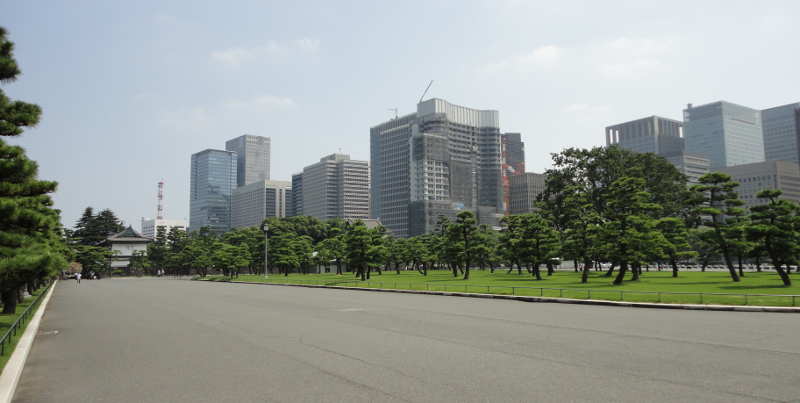 Kokyo Gaien
Kokyo Gaien
The most popular viewpoint is the one generally known as
Nijubashi. From here it is possible to see two access bridges to the palace's internal park and an original turret from the ancient Edo castle. The closest stone bridge is called
Seimon Ishibashi (or also
Meganebashi). The farthest bridge, made of iron, is called
Seimon Tetsubashi (or also
Nijūbashi). The term Nijubashi means "double bridge", because before being rebuilt in iron, the original bridge was made of wood and was built over a second auxiliary bridge due to the depth of the moat. For this reason, both bridges are often mistakenly referred to collectively as Nijūbashi.
In the background you can also see a turret, the
Fushimi Yagura. This was originally built in Kyoto, at Fushimi Castle, but Shogun Tokugawa Iemitsu (reign 1623-1651) brought it to Edo (Tokyo) and it has survived to this day. This is the only surviving tower of the ancient castle in this part of the building. Two other turrets have survived to this day, for a total of three, but are located within the east gardens (see below).
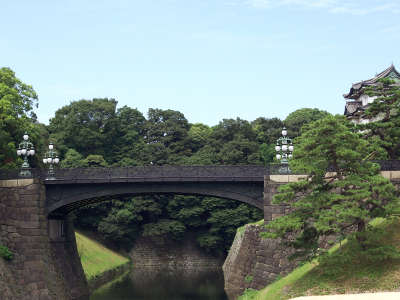
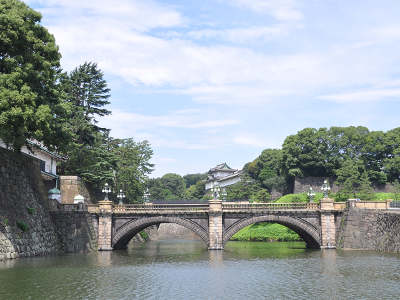 the Nijubashi and Meganebashi bridges to access the Imperial Palace, seen from Kokyo Gaien
the Nijubashi and Meganebashi bridges to access the Imperial Palace, seen from Kokyo Gaien
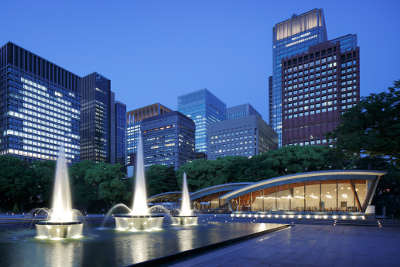
Wadakura Fountain Park
If you come on foot from Tokyo station, this small park is one of the first places you meet, on the right, next to the outermost water moat. The original park was built in 1961 and was renovated in 1995 to commemorate the marriage of Prince Akihito and Princess Michiko. The design is very modern, with three fountains spraying water upwards, narrow canals, and a waterfall with water falling from a modern work of art. Inside the park there are also a café and a restaurant overlooking the fountains. In the evening the fountains are illuminated and there is a very relaxing atmosphere.
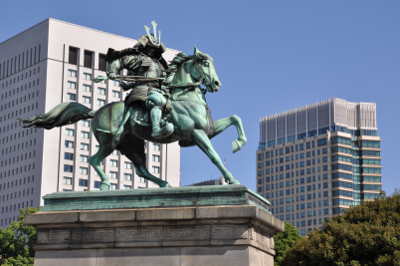
Statue of Kusunoki Masashige
This bronze statue is located in the southeast corner of Kokyo Gaien and is one of the three main bronze statues in Tokyo. It depicts Kusunoki Masashige (1294-1336), a samurai who through various historical vicissitudes has become a symbol of courage and loyalty to the emperor.
The Imperial Palace East Gardens
Admission:: free
Opening hours: 9-17 from March to mid-April and all of September; 9-18 from mid-April to August; 9-16:30 in October; 9-16 from November to February
Closing days: Monday, Friday
The oriental gardens of the Imperial Palace are open to the public all year round. These gardens stand on the land that once housed the main buildings of
Edo Castle, the residence of the Tokugawa shogun who ruled Japan from 1603 to 1867 and later also of Emperor Meiji between 1868 and 1888, before he moved to the newly built imperial palace. There are three entrances to the park. The main one is the
Otemon gate on the side of Tokyo Station. Two other entrances are located north of the park (
Kita-hanebashi-mon gate and
Hirakawa gate). The gardens are very large and include large green lawns, several archaeological remains of the ancient Edo Castle scattered here and there, and a traditional Japanese style garden (
Ninomaru Garden) with a tea house (
Suwa no Chaya). The tea house does not belong to the ancient castle but was built in 1912 at the behest of Emperor Meiji.
Remains of the ancient Edo Castle
None of the great buildings of the old castle have survived to this day, but many traces still remain within these gardens. In addition to moats, walls, entrance gates, and archaeological remains of buildings that no longer exist, some minor buildings have survived entirely. In particular, two turrets (a third is located inside the current imperial palace, see above), three guard rooms, and a warehouse:
- the Sakurada-Niju-Yagura, an external turret located in a corner of the moat and also visible from the outside. The turret was destroyed during the earthquake of 1923 and was rebuilt soon after.
- the Fujimi yagura, built in 1659. It owes its name to the fact that Mount Fuji could once be seen from it. As the main keep of Edo Castle was destroyed in 1657 and not rebuilt, the Fujimi-yagura, once built, assumed its role.
- the Dōshin-bansho Guardhouse, one of the guardhouses where the samurai who constantly guarded the castle were stationed.
- the Hyaku-nin-bansho Guardhouse, another guardhouse, the largest of all with its 45 meters in length, which could accommodate up to 100 guards, as the literal translation of the name itself suggests.
- the Ō-bansho Guardhouse, the guardhouse manned by high-ranking samurai, located where the main internal gate once stood.
- the Fujimi-tamon Defense House once used to store weapons and various tools. The only survivor of fifteen such warehouses that once existed. It is also the only original Edo Castle building that can be entered.
- the foundations of the keep, that is all that remains of the main keep of the castle, which was destroyed by a fire as early as 1657 and since then never rebuilt.
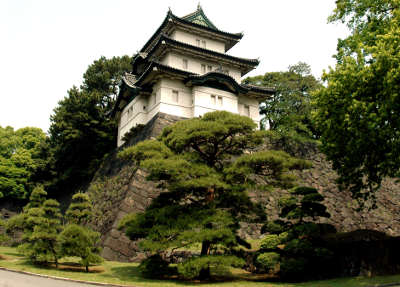
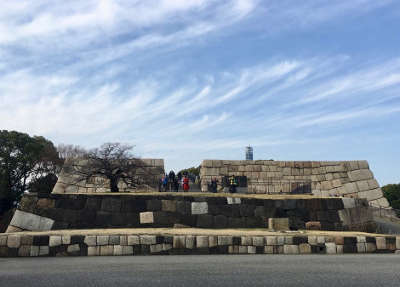 Fujimi Yagura and the foundations of the ancient castle keep
Fujimi Yagura and the foundations of the ancient castle keep
Kitanomaru Park
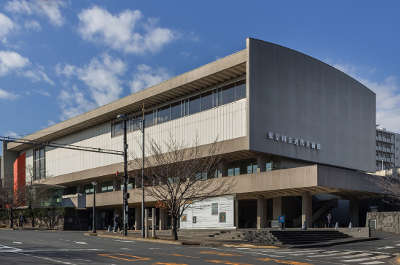
National Museum of Modern Art (Momat)
(opening hours 10-17, 10-20 fri-sat, closed on mondays)
Momat is Tokyo's premier museum for modern art. The collection includes many important Japanese artists of the twentieth century, as well as some Western works. The entrance fee varies according to the temporary exhibitions inside the museum. Exhibition calendar.
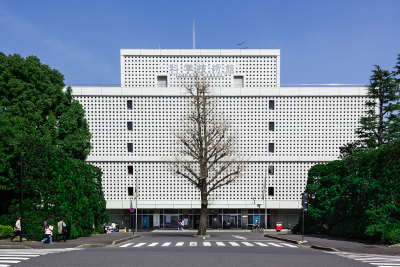
Science Museum
(admission 880¥ (adults), opening hours 9:30-16:50, sometimes closed on Wednesdays)
A science museum with numerous exhibits to teach visitors many scientific concepts in an interactive way, particularly in the field of physics. The museum was designed primarily for children and teenagers, and is in fact a popular school trip destination. It is a good educational museum, except that many things are described only in Japanese and it is difficult for a foreigner, especially a child, to appreciate all the contents. Of all the science museums in Tokyo, it is the least popular among foreign tourists, who prefer the Miraikan in Odaiba for example.
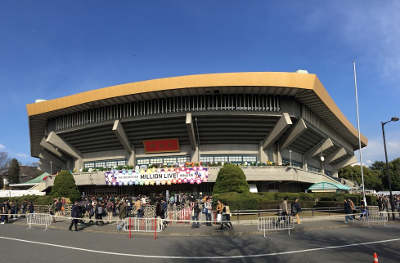
Nippon Budokan
The Nippon Budokan is an arena built to host the Judo competitions during the 1964 Tokyo Olympics. Today the building is used to host martial arts competitions but also other types of events, especially concerts.
Chidorigafuchi Park
The term
Chidorigafuchi refers precisely to one of the water-filled moats northwest of the Imperial Palace. This name is said to derive from its unusual shape. The structure of the moat walls resembles plovers, called chidori in Japanese.
Nowadays, the term
Chidorigafuchi Park refers to a long, thin park that runs along the moat and is full of cherry trees (there are at least 270 of them). This is one of the most beautiful places in Tokyo to enjoy the cherry blossom in spring. The large branches of the trees almost touch the water. As we move away from the days of flowering, the water surface of the moat becomes covered with cherry petals, creating the illusion of a pink river.
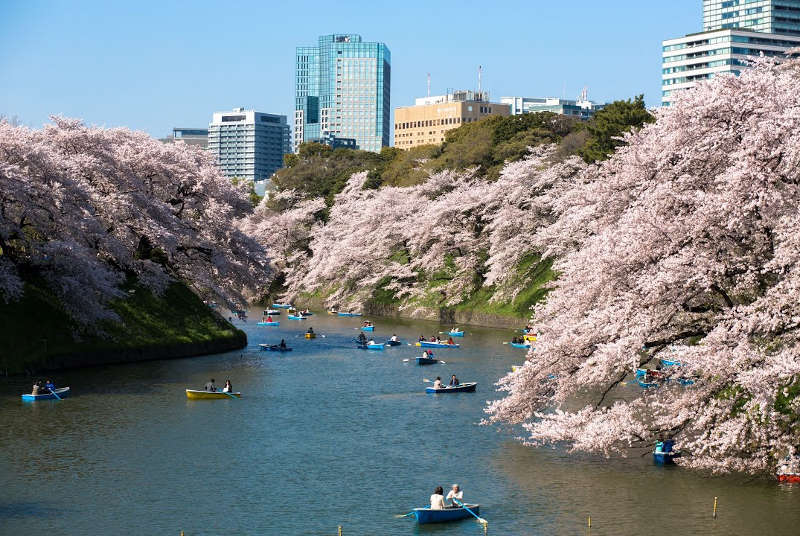 cherry blossoms in Chidorigafuchi
cherry blossoms in Chidorigafuchi
Rent a boat or a pedal boat
(opening hours 11-17, until 17:30 on weekends, closed on Mondays)
Along the park there is a small pier, run by the local government, which rents boats to take a ride in the imperial moat. Boat rental is a very common custom in Japan in small lakes inside parks.
Rowing boats for 2-3 people and two-seater pedal boats are available for hire. Renting a boat costs 500¥ for every half hour. During the period of the Chiyoda Sakura Festival, the opening hours are extended until the evening and prices increase (800¥ for half an hour).
Chiyoda Sakura festival
During the peak days of flowering, usually between the last week of March and the first of April (but the exact dates vary from year to year) a festival is held around this moat. The cherry trees in bloom are illuminated from sunset until at least 10 pm. Coming for a walk here becomes a magical experience. Around this park, and in particular in the area in front of the
Yasukuni Shrine, you will various food and drink stalls.
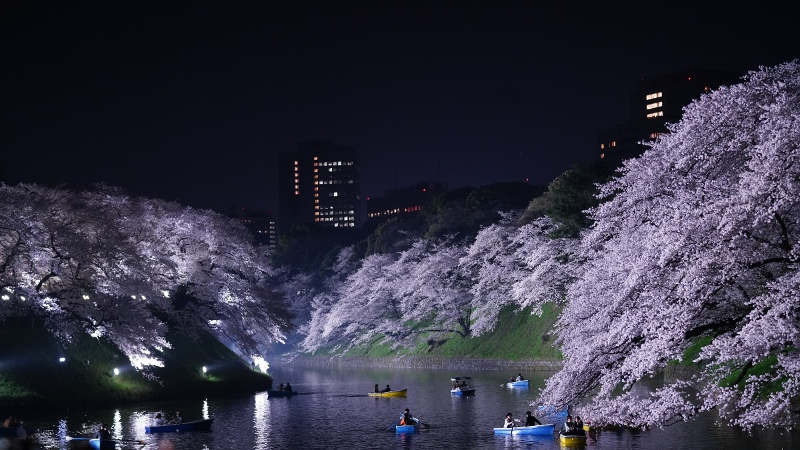 Chidorigafuchi with lights during the sakura festival
Chidorigafuchi with lights during the sakura festival
Where to stay near the Tokyo Imperial Palace
Luxury hotels overlooking the Tokyo Imperial Palace
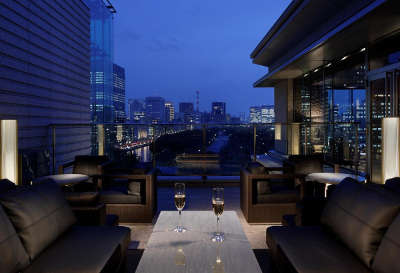 A luxury hotel located right in front of the imperial moat, where the fountains of Wadakura Park are located. The entrance to the east gardens is just 100 meters from the hotel, while Tokyo station is 600 meters away. The cheapest rooms in this hotel are already comparable to mini apartments in size, and many have balconies overlooking the Imperial Park or the city. Inside the hotel there are seven restaurants and three bars.
Price range: double rooms 50,000-70,000¥.
A luxury hotel located right in front of the imperial moat, where the fountains of Wadakura Park are located. The entrance to the east gardens is just 100 meters from the hotel, while Tokyo station is 600 meters away. The cheapest rooms in this hotel are already comparable to mini apartments in size, and many have balconies overlooking the Imperial Park or the city. Inside the hotel there are seven restaurants and three bars.
Price range: double rooms 50,000-70,000¥.
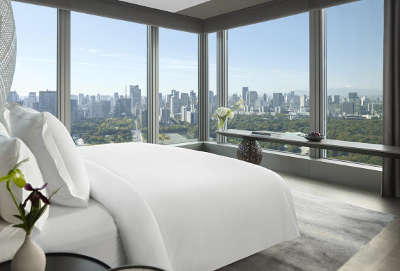 Another luxury hotel 500 meters from the entrance to the east gardens of the Imperial Palace and Otemachi station. Here too the rooms are huge, over fifty square meters. When booking, you can choose between rooms with a view of the city and rooms with a view of the imperial gardens. Inside the hotel you will also find a spa with heated indoor pool and several restaurants, one of which with a splendid panoramic terrace. Courtesy cars with drivers are available to guests within a 3 km radius of the hotel.
Price range: double rooms 60,000-80,000¥.
Another luxury hotel 500 meters from the entrance to the east gardens of the Imperial Palace and Otemachi station. Here too the rooms are huge, over fifty square meters. When booking, you can choose between rooms with a view of the city and rooms with a view of the imperial gardens. Inside the hotel you will also find a spa with heated indoor pool and several restaurants, one of which with a splendid panoramic terrace. Courtesy cars with drivers are available to guests within a 3 km radius of the hotel.
Price range: double rooms 60,000-80,000¥.
Hotels for all budgets
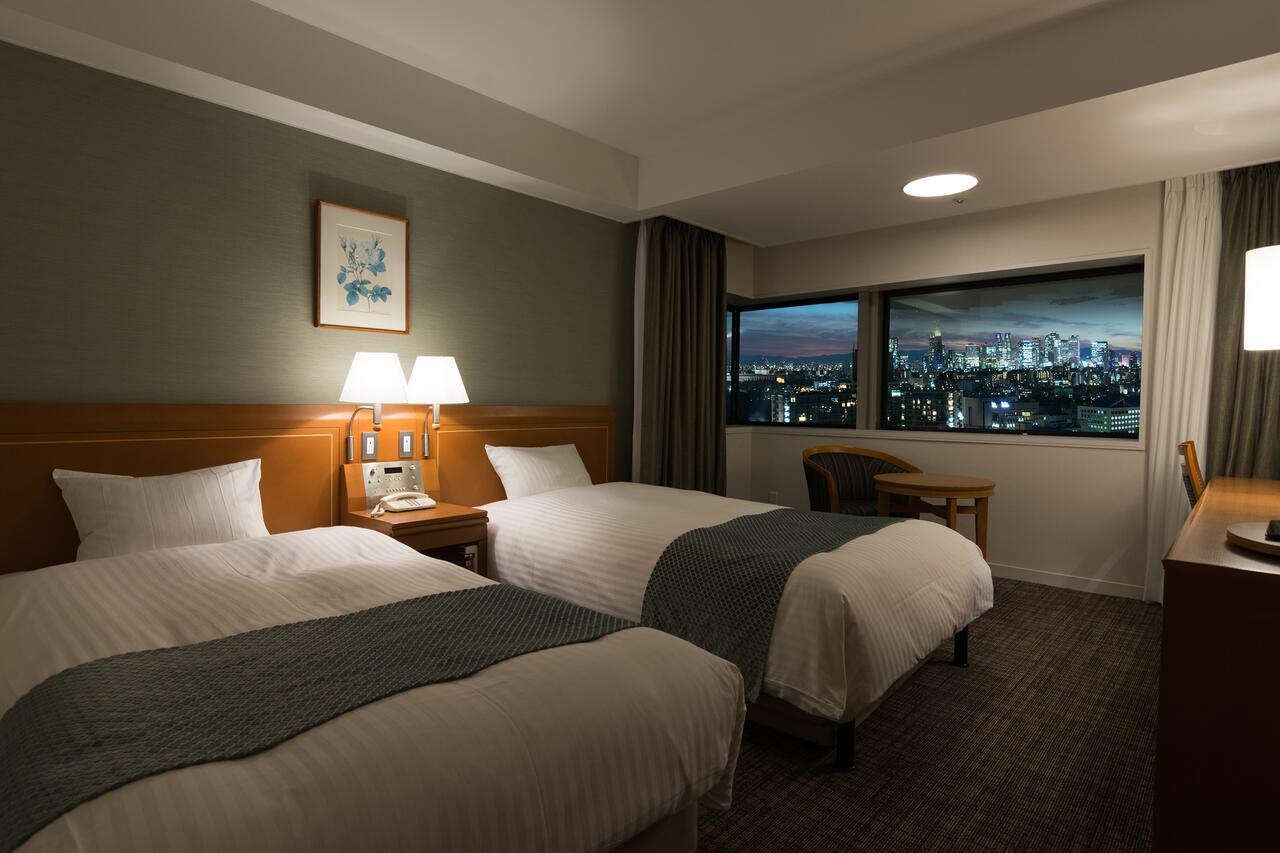 This high-rise hotel is located 800 meters from Chidorigafuchi, near the Nagatacho metro station. It is one of the cheapest high-rise hotels in Tokyo where you can sleep in rooms with a panoramic view of the city. All rooms are located on the 14th floor and up. Other than that, this is a good average business hotel.
Price range: single rooms 5,000-7,000¥, double rooms 7,000-9,000¥.
This high-rise hotel is located 800 meters from Chidorigafuchi, near the Nagatacho metro station. It is one of the cheapest high-rise hotels in Tokyo where you can sleep in rooms with a panoramic view of the city. All rooms are located on the 14th floor and up. Other than that, this is a good average business hotel.
Price range: single rooms 5,000-7,000¥, double rooms 7,000-9,000¥.
Cheap business hotels
The perimeter of the Imperial Palace is very large. While hotel prices are very high in the Marunouchi/Tokyo Station area, in other less central areas there are more affordable rates. In particular, near
Hanzomon and
Jimbocho stations you can stay with rates starting from 3500¥ per night for a single room. If interested in the area, take a look at:
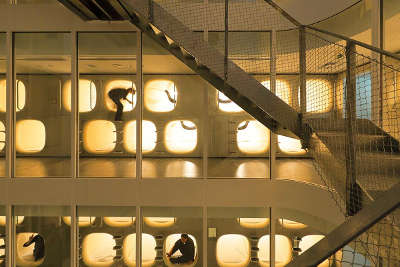 This capsule hotel is one of the rare ultra-low-cost alternatives near the Tokyo Imperial Palace. It is located about 300 meters from one of the entrances to the east gardens of the palace, north side. Jimbocho's interesting bookstore district isn't far away. Takebashi Metro Station is also nearby. The hotel is also open to women, with reserved floors.
Price range: capsule 2,500-3,500¥.
This capsule hotel is one of the rare ultra-low-cost alternatives near the Tokyo Imperial Palace. It is located about 300 meters from one of the entrances to the east gardens of the palace, north side. Jimbocho's interesting bookstore district isn't far away. Takebashi Metro Station is also nearby. The hotel is also open to women, with reserved floors.
Price range: capsule 2,500-3,500¥.
How to get to the Tokyo Imperial Palace area
The most used station to reach the Imperial Palace area is usually
Tokyo station, using the exits on the side of
Marunouchi. From this major station, the first water-filled moat is just 300 meters away. The station is symbolically connected to the Imperial Palace both on the surface and underground. On the surface there is
Gyoko Dori, an elegant tree-lined avenue with a pedestrian area in the center. Just below this boulevard, there is a long underground pedestrian tunnel known as
Gyoko-dori Underground Gallery, along which small art exhibitions are usually set up.
Furthermore, several metro stations are scattered here and there around the huge perimeter of the imperial palace. In particular, these could be useful:
- Nijūbashimae station (Tokyo Metro Chiyoda line) opposite Kokyo Gaien.
- Otemachi station (Tokyo Metro Chiyoda line, Tozai line, Marunouchi line, Hanzomon line, Toei Mita line), a few meters from the main entrance gate to the East Gardens (Otemon Gate).
- Hanzōmon station (Tokyo Metro Hanzomon line) near Chidorigafuchi Park and several budget hotels recommended on this page.
- Kudanshita station (Tokyo Metro Hanzomon line, Tozai line, Toei Shinjuku line), also near the Chidorigafuchi Park but further north, also close to the Yasukuni Shrine and the Nippon Budokan.
- Takebashi station (Tokyo Metro Tozai line), near the Hirakawa Gate to enter the East Gardens, the Momat and the science museum.
Map of the Tokyo Imperial Palace area
Guided tours, activities and other things to do
If you are planning a trip to Japan and you want to do something more than just visiting famous places and monuments, we suggest you to use
Rakuten Travel Experiences.
How to use Rakuten Travel Experiences
Rakuten Travel is a very useful website to
enrich your travel experience, especially if you are going solo or it's your first time in Japan.
Because of the language barrier (and more), in Japan it is very difficult to interact with the locals and to get off the tourist track.
Thanks to Rakuten Travel you can find a lot of interesting and sometimes unique
guided tours and activities all over Japan (and not only in Japan), that you would otherwise never be able to enjoy.
But there's more: on Rakuten Travel you can also
buy tickets for several famous attractions, events, transportation and other useful services for tourists. Last but not least, you can
reserve a table in hundreds of restaurants.
Some examples
Take a look at Rakuten Travel Experiences
You may also be interested in





 A luxury hotel located right in front of the imperial moat, where the fountains of Wadakura Park are located. The entrance to the east gardens is just 100 meters from the hotel, while Tokyo station is 600 meters away. The cheapest rooms in this hotel are already comparable to mini apartments in size, and many have balconies overlooking the Imperial Park or the city. Inside the hotel there are seven restaurants and three bars.
Price range: double rooms 50,000-70,000¥.
A luxury hotel located right in front of the imperial moat, where the fountains of Wadakura Park are located. The entrance to the east gardens is just 100 meters from the hotel, while Tokyo station is 600 meters away. The cheapest rooms in this hotel are already comparable to mini apartments in size, and many have balconies overlooking the Imperial Park or the city. Inside the hotel there are seven restaurants and three bars.
Price range: double rooms 50,000-70,000¥.
 Another luxury hotel 500 meters from the entrance to the east gardens of the Imperial Palace and Otemachi station. Here too the rooms are huge, over fifty square meters. When booking, you can choose between rooms with a view of the city and rooms with a view of the imperial gardens. Inside the hotel you will also find a spa with heated indoor pool and several restaurants, one of which with a splendid panoramic terrace. Courtesy cars with drivers are available to guests within a 3 km radius of the hotel.
Price range: double rooms 60,000-80,000¥.
Another luxury hotel 500 meters from the entrance to the east gardens of the Imperial Palace and Otemachi station. Here too the rooms are huge, over fifty square meters. When booking, you can choose between rooms with a view of the city and rooms with a view of the imperial gardens. Inside the hotel you will also find a spa with heated indoor pool and several restaurants, one of which with a splendid panoramic terrace. Courtesy cars with drivers are available to guests within a 3 km radius of the hotel.
Price range: double rooms 60,000-80,000¥.
 This high-rise hotel is located 800 meters from Chidorigafuchi, near the Nagatacho metro station. It is one of the cheapest high-rise hotels in Tokyo where you can sleep in rooms with a panoramic view of the city. All rooms are located on the 14th floor and up. Other than that, this is a good average business hotel.
Price range: single rooms 5,000-7,000¥, double rooms 7,000-9,000¥.
This high-rise hotel is located 800 meters from Chidorigafuchi, near the Nagatacho metro station. It is one of the cheapest high-rise hotels in Tokyo where you can sleep in rooms with a panoramic view of the city. All rooms are located on the 14th floor and up. Other than that, this is a good average business hotel.
Price range: single rooms 5,000-7,000¥, double rooms 7,000-9,000¥.
 This capsule hotel is one of the rare ultra-low-cost alternatives near the Tokyo Imperial Palace. It is located about 300 meters from one of the entrances to the east gardens of the palace, north side. Jimbocho's interesting bookstore district isn't far away. Takebashi Metro Station is also nearby. The hotel is also open to women, with reserved floors.
Price range: capsule 2,500-3,500¥.
This capsule hotel is one of the rare ultra-low-cost alternatives near the Tokyo Imperial Palace. It is located about 300 meters from one of the entrances to the east gardens of the palace, north side. Jimbocho's interesting bookstore district isn't far away. Takebashi Metro Station is also nearby. The hotel is also open to women, with reserved floors.
Price range: capsule 2,500-3,500¥.